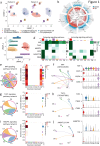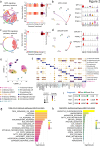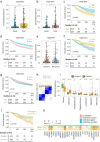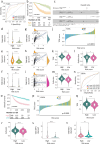Revealing the role of SPP1+ macrophages in glioma prognosis and therapeutic targeting by investigating tumor-associated macrophage landscape in grade 2 and 3 gliomas
- PMID: 38515213
- PMCID: PMC10956315
- DOI: 10.1186/s13578-024-01218-4
Revealing the role of SPP1+ macrophages in glioma prognosis and therapeutic targeting by investigating tumor-associated macrophage landscape in grade 2 and 3 gliomas
Abstract
Background: Glioma is a highly heterogeneous brain tumor categorized into World Health Organization (WHO) grades 1-4 based on its malignancy. The suppressive immune microenvironment of glioma contributes significantly to unfavourable patient outcomes. However, the cellular composition and their complex interplays within the glioma environment remain poorly understood, and reliable prognostic markers remain elusive. Therefore, in-depth exploration of the tumor microenvironment (TME) and identification of predictive markers are crucial for improving the clinical management of glioma patients.
Results: Our analysis of single-cell RNA-sequencing data from glioma samples unveiled the immunosuppressive role of tumor-associated macrophages (TAMs), mediated through intricate interactions with tumor cells and lymphocytes. We also discovered the heterogeneity within TAMs, among which a group of suppressive TAMs named TAM-SPP1 demonstrated a significant association with Epidermal Growth Factor Receptor (EGFR) amplification, impaired T cell response and unfavourable patient survival outcomes. Furthermore, by leveraging genomic and transcriptomic data from The Cancer Genome Atlas (TCGA) dataset, two distinct molecular subtypes with a different constitution of TAMs, EGFR status and clinical outcomes were identified. Exploiting the molecular differences between these two subtypes, we developed a four-gene-based prognostic model. This model displayed strong associations with an elevated level of suppressive TAMs and could be used to predict anti-tumor immune response and prognosis in glioma patients.
Conclusion: Our findings illuminated the molecular and cellular mechanisms that shape the immunosuppressive microenvironment in gliomas, providing novel insights into potential therapeutic targets. Furthermore, the developed prognostic model holds promise for predicting immunotherapy response and assisting in more precise risk stratification for glioma patients.
Keywords: EGFR; Glioma; Immune suppression; TAM-SPP1; Tumor-associated macrophages.
© 2024. The Author(s).
Conflict of interest statement
All authors declared that there are no competing interest.
Figures







References
-
- Jiang T, Tang G, Lin Y, Peng X, Zhang X, Zhai X, et al. Prevalence estimates for primary brain tumors in China: a multi-center cross-sectional study. Chin Med J. 2011;124:2578–2583. - PubMed
-
- Collaborators G 2016 B and OCC. Patel AP, Fisher JL, Nichols E, Abd-Allah F, Abdela J, et al. Global, regional, and national burden of brain and other CNS cancer, 1990–2016: a systematic analysis for the Global Burden of Disease Study 2016. Lancet Neurol. 2019;18:376–393. doi: 10.1016/S1474-4422(18)30468-X. - DOI - PMC - PubMed
LinkOut - more resources
Full Text Sources
Research Materials
Miscellaneous

